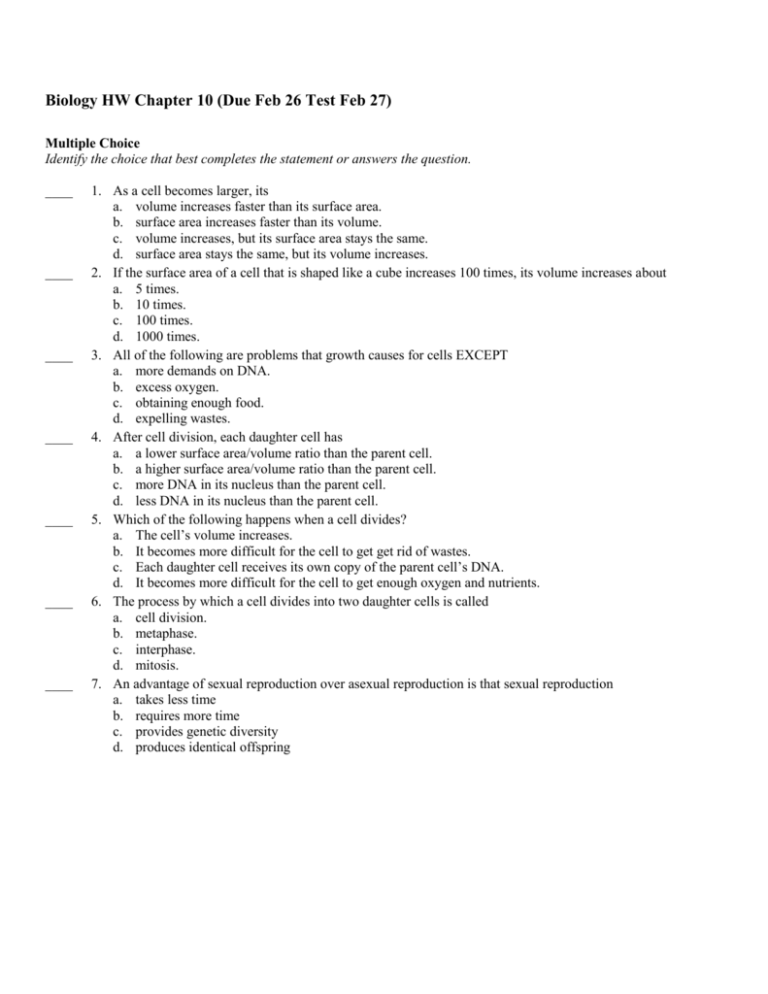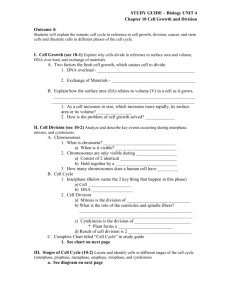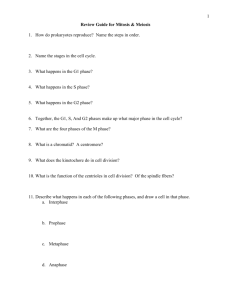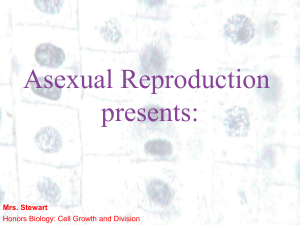Biology-HW-Chapter-10
advertisement

Biology HW Chapter 10 (Due Feb 26 Test Feb 27) Multiple Choice Identify the choice that best completes the statement or answers the question. ____ ____ ____ ____ ____ ____ ____ 1. As a cell becomes larger, its a. volume increases faster than its surface area. b. surface area increases faster than its volume. c. volume increases, but its surface area stays the same. d. surface area stays the same, but its volume increases. 2. If the surface area of a cell that is shaped like a cube increases 100 times, its volume increases about a. 5 times. b. 10 times. c. 100 times. d. 1000 times. 3. All of the following are problems that growth causes for cells EXCEPT a. more demands on DNA. b. excess oxygen. c. obtaining enough food. d. expelling wastes. 4. After cell division, each daughter cell has a. a lower surface area/volume ratio than the parent cell. b. a higher surface area/volume ratio than the parent cell. c. more DNA in its nucleus than the parent cell. d. less DNA in its nucleus than the parent cell. 5. Which of the following happens when a cell divides? a. The cell’s volume increases. b. It becomes more difficult for the cell to get get rid of wastes. c. Each daughter cell receives its own copy of the parent cell’s DNA. d. It becomes more difficult for the cell to get enough oxygen and nutrients. 6. The process by which a cell divides into two daughter cells is called a. cell division. b. metaphase. c. interphase. d. mitosis. 7. An advantage of sexual reproduction over asexual reproduction is that sexual reproduction a. takes less time b. requires more time c. provides genetic diversity d. produces identical offspring Figure 10–1 ____ ____ 8. Which advantage of having the a cell’s DNA bundled into separate chromosomes is illustrated in Figure 10–1 above? a. During DNA replication, the number of chromosomes is cut in half. b. During DNA replication, the number of chromosomes stays the same. c. During cell division, each daughter cell will get the same number of genes. d. During cell division, each daughter cell will get a random number of genes. 9. Which of the following lists structures from smallest to largest? a. chromosome, supercoil, coil, nucleosome, double helix b. chromosome, coil, double helix, nucleosome, supercoil c. double helix, nucleosome, coil, supercoil, chromosome d. nucleosome, coil, double helix, chromosome, supercoil Figure 10–2 ____ 10. A multicellular organism begins life as a single cell—a fertilized egg with a complete set of chromosomes. The picture in Figure 10–2 above shows how the cell divides to become two cells, then four cells, eight cells, and so on. Which of the following statements best describes what happens during this process? a. Chromosomes are duplicated before cell division so that each new daughter cell has a complete set. b. Chromosomes are divided evenly during cell division so that each new daughter cell has an equal share of the original set. c. Chromosomes are stored in the original cell to direct the division of all daughter cells, which do not have their own chromosomes. d. Chromosomes are randomly distributed during cell division so that some new cells have partial sets while others have complete sets. ____ 11. When during the cell cycle are chromosomes visible? a. only during interphase b. only when they are being replicated c. only during cell division d. only during the G1 phase ____ 12. During which phase in the cell cycle does mitosis happen? a. G1 phase b. G2 phase c. M phase d. S phase ____ 13. Which pair includes a phase of the cell cycle and a cellular process that occurs during that phase? a. G1 phase, DNA replication b. G2 phase, preparation for mitosis c. S phase, cell division d. M phase, cell growth ____ 14. When during the cell cycle is a cell’s DNA replicated? a. G1 phase b. G2 phase c. S phase d. M phase ____ 15. Which event occurs during interphase? a. The cytoplasm divides. b. Centrioles duplicate. c. Spindle fibers begin to form. d. Centromeres divide. Figure 10–3 ____ 16. Cell division is represented in Figure 10–3 by the letter a. A. b. B. c. C. d. D. Animal Cell Figure 10–4 ____ 17. In Figure 10–4, what role does structure A play in mitosis? a. replicate DNA b. increase cell volume c. connect to spindle fibers d. dissolve nuclear envelope Figure 10–5 ____ 18. The structure labeled A in Figure 10–5 is called the a. centromere. b. centriole. c. sister chromatid. d. spindle. ____ 19. The structures labeled B in Figure 10–5 are called a. centromeres. b. centrioles. c. sister chromatids. d. spindles. ____ 20. During which phase(s) of mitosis are structures like the one shown in Figure 10–5 visible? a. anaphase only b. prophase, metaphase, and anaphase c. metaphase only d. anaphase and interphase ____ 21. The first phase of mitosis is called a. prophase. b. anaphase. c. metaphase. d. interphase. ____ 22. During which phase of mitosis do the chromosomes line up along the middle of the dividing cell? a. prophase b. telophase c. metaphase d. anaphase ____ 23. Which of the following represents the phases of mitosis in their proper sequence? a. prophase, metaphase, anaphase, telophase b. interphase, prophase, metaphase, anaphase, telophase c. interphase, prophase, metaphase, telophase d. prophase, anaphase, metaphase, telophase ____ 24. What is the role of the spindle fibers during mitosis? a. They help separate the chromosomes. b. They break down the nuclear membrane. c. They duplicate the DNA. d. They make the chromosomes visible. ____ 25. The two main stages of cell division are called a. mitosis and interphase. b. synthesis and cytokinesis. c. the M phase and the S phase. d. mitosis and cytokinesis. ____ 26. During normal mitotic cell division, a parent cell that has four chromosomes will produce two daughter cells, each containing a. two chromosomes. b. four chromosomes. c. eight chromosomes. d. sixteen chromosomes. ____ 27. One difference between cell division in plant cells and in animal cells is that plant cells have a. centrioles. b. centromeres. c. a cell plate. d. chromatin. Figure 10–6 ____ 28. Some cells form a cell plate during cytokinesis. Which of the following is true of the cells in Figure 10–6 above? a. Both cells form cell plates during cytokinesis. b. Neither cell forms a cell plate during cytokinesis. c. Only cell A forms a cell plate during cytokinesis. d. Only cell B forms a cell plate during cytokinesis. ____ 29. When cells are grown in a laboratory, which of the following is a factor that can stop normal cells from dividing? a. contact with other cells b. growth factors c. a cut in the skin d. injection of cyclin ____ 30. Which of the following explains why normal cells grown in a petri dish tend to stop growing once they have covered the bottom of the dish? a. The cells lack cyclin. b. The petri dish inhibits cell growth. c. Contact with other cells stops cell growth. d. Most cells grown in petri dishes have a defective p53. ____ 31. In eukaryotic cells, the timing of the cell cycle is regulated by a. centrioles. b. cyclins. c. spindle fibers. d. the nuclear envelope. ____ 32. Cyclins are a family of closely related proteins that a. regulate the cell cycle. b. produce p53. c. cause cancer. d. work to heal wounds. ____ 33. Which of the following are external regulators of the cell cycle? a. cyclins b. growth factors c. mitotic spindles d. cancer cells ____ 34. Cancer is a disorder in which some cells have lost the ability to control their a. size. b. spindle fibers. c. growth rate. d. surface area. ____ 35. Cancer cells form masses of cells called a. tumors. b. cyclins. c. growth factors. d. p53. ____ 36. A cell with a defective p53 gene is likely to a. stop responding to growth regulators. b. stop dividing to produce daughter cells. c. generate hormones that combat tumors. d. produce cells without a defective p53 gene. ____ 37. Cancer affects a. humans only. b. unicellular organisms only. c. multicellular organisms only. d. multicellular and unicellular organisms. ____ 38. During early development, all cells in the embryo of a multicellular organism are identical. Later on in development, the cells will become specialized through a process called a. apoptosis. b. cytokinesis. c. differentiation. d. interphase. ____ 39. Why are stem cells important? a. They have specialized DNA. b. They are incapable of becoming cancer cells. c. They have the potential to undergo cell division. d. They have the potential to develop into other cell types. ____ 40. Which of the following is a possible future benefit of stem cell research? a. developing a vaccine for cancer b. reversing damage from a heart attack c. generating embryos from nonliving tissue d. increasing a person’s intelligence quotient Modified True/False Indicate whether the statement is true or false. If false, change the identified word or phrase to make the statement true. ____ 41. As a cell’s size increases, its ratio of surface area to volume increases. _________________________ Figure 10–5 ____ 42. The structure shown in Figure 10–5 is a replicated chromosome. _________________________ ____ 43. In eukarotes, the spindle breaks down during prophase and re-forms during telophase. _________________________ ____ 44. Typically, the longest phase of mitosis is metaphase. _________________________ Figure 10–7 ____ 45. The cell shown in step E in Figure 10-7 above is undergoing telophase. _________________________ ____ 46. During cytokinesis, a cell undergoing cell division finally splits into two daughter cells. _________________________ ____ 47. Proteins called cyclins help regulate the cell cycle. _________________________ ____ 48. Cancer is a disorder in which some of the body’s cells lose the ability to control growth and division. _________________________ ____ 49. Stem cells taken from embryos are totipotent. _________________________ ____ 50. People opposed to stem cell research argue that it is unethical to collect embryonic stem cells because it usually preserves an embryo. ______________________________ Completion Complete each statement. 51. The larger a cell becomes, the ____________________ efficiently it is able to function. 52. During ____________________ reproduction, cells can produce genetically different offspring, whereas during ____________________ reproduction, cells produce genetically identical offspring. 53. Cell division occurs in two main stages, the first of which is called _________________________. 54. Together, the G1 phase, S phase, and G2 phase are called ____________________. 55. A cell that has 5 chromosomes in the G1 phase will have ____________________ chromatids in the G2 phase. Figure 10–7 56. The phase of mitosis shown in step C in the Figure 10–7 above is called ____________________. Figure 10–8 57. Look at Figure 10–8. Once structure A has completely formed, another phase of the cell cycle will start. This phase will be called ___________________. 58. The structure labeled A in Figure 10–8 is called the _________________________. 59. The process shown in Figure 10–8 occurs only in ____________________ cells that are going through cytokinesis. 60. Embryonic stem cells gathered from the inner cell mass of the blastocyst are called ____________________ because they can develop into most, but not all human cell types. Short Answer 61. What effect does cell size have on a cell’s ability to efficiently carry out its activities? 62. How does packaging genetic information into chromosomes help the process of cell division? 63. How are metaphase and anaphase different? 64. Explain the difference between cytokinesis in plant cells and animal cells. 65. The level of cyclins in a cell increases during the M phase of the cell cycle. What might happen to a cell if no cyclins were present during the M phase?









